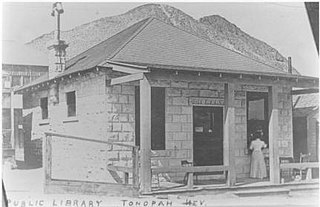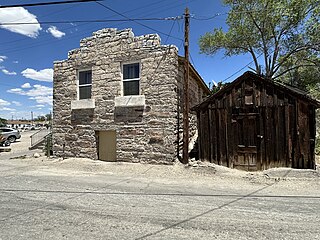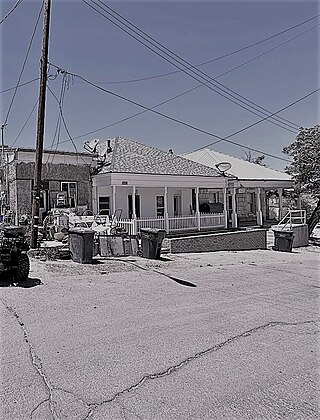
The Mizpah Hotel is a historic hotel in Tonopah, Nevada, U.S. It is a member of Historic Hotels of America, the official program of the National Trust for Historic Preservation.

The Nye County Courthouse in Tonopah, Nevada is a two-story rusticated stone building. Its Romanesque Revival entrance and pointed dome are unique in Nevada. The courthouse was built following the move of the Nye County seat from Belmont to Tonopah in 1905.

The Tonopah Public Library in Tonopah, Nevada was the third public library in Nevada.The one story stone building was designed by John J. Hill and was completed in 1906. The library was established by local residents Grace R. Moore and Marjorie Moore Brown to house a gift of 200 books from George F. Weeks.

Wright Block is a property in Grand Forks, North Dakota that was listed on the National Register of Historic Places in 1982.

The Telephone Co. Building in Grand Forks, North Dakota, United States, was built in 1904. It was listed on the National Register of Historic Places in 1982.
The BPOE Lodge: Golden Block, also referred to as Golden Square, was a building in Grand Forks, North Dakota that was listed on the National Register of Historic Places, but was removed from the National Register in 2004.
Dinnie Block was a property in Grand Forks, North Dakota. It was removed from the National Register of Historic Places in 2004.

The Bass Building is a historic building located at 119 St. Patrick in Tonopah, Nevada. Built in 1904, the building is the third oldest stone commercial building in Tonopah. The building has a simple stone design reflective of a transitional period between rustic and well-crafted stone buildings. A. A. Bass built the structure as a lodging house; it later served as offices for a telephone company and as a fraternal lodge. A 1912 fire gutted the building's interior, but Bass rebuilt it the following year.

The Tonopah Liquor Company Building is a historic building located on Main St. in Tonopah, Nevada. The building was constructed in 1906 by the Tonopah Liquor Company. The stone building was designed in the Classical Revival style and features a large pediment with a stone cornice. While the building was one of many stone structures built in Tonopah's early history, it is now one of only four remaining in the town; a local historic survey claimed it to be the most well-crafted of the remaining buildings.

The Tonopah Volunteer Firehouse and Gymnasium is a historic fire station located at the intersection of Brougher and Burro Streets in Tonopah, Nevada. Built in 1907, the firehouse housed Tonopah's volunteer fire department. The firehouse was built by Tonopah's newly appointed fire chief to address inadequacies in the town's fire protection services, which had failed to stop a major fire in 1904. A gymnasium for the firefighters was constructed next to the fire station in 1908. Tonopah still suffered three major fires after its fire station was built, including a 1920 fire which damaged the station itself; the building was subsequently restored to its original condition.
The Nye County Mercantile Company Building is a historic building located at 147 Main St. in Tonopah, Nevada. The two-story concrete block building was constructed in 1905. While concrete blocks were a popular building material in the era, the building was one of the first in Tonopah to be built with the blocks. Businessman Henry C. Cutting built the building to house his mercantile business. Cutting opened the first mercantile business in Tonopah; he reorganized the business as the Nye County Mercantile Company when he constructed its new building.

The Wieland Brewery Building is a historic building located on Mineral Street in Tonopah, Nevada. Built in 1901, the building was the first stone building constructed in Tonopah. It was also one of the first permanent buildings built in the town, which was still primarily a mining camp at the time. The building had several owners in its early years. It was apparently first owned by H.C. Brougher, but businessman Harry King bought the brewery by the end of 1901. King sold the brewery to two other businessmen in the spring 1902 but purchased it again by the following October. At the end of 1902, King added a crafted parapet to the building, which indicates that Tonopah had local stone craftsmen by that time.

The Tonopah Main Post Office, also known as US Post Office–Tonopah Main, is the main post office in Tonopah, Nevada. Built in 1941, the post office was the first and only federally constructed post office in the city. The post office was designed in a Starved Classical style typical of federal buildings of the era. The government began planning the post office in 1937, and its site was chosen in 1940. The building's cornerstone was laid in May 1941; a civic ceremony and parade marked the occasion. The post office opened for business on December 7, 1941, the same day as the attack on Pearl Harbor. In addition to serving as Tonopah's post office, the building also houses government offices in its basement.

The Cal Shaw Adobe Duplex is an adobe house located at 129 Central Street in Tonopah, Nevada. The house, which was built in 1905, is typical of the adobe homes commonly built in Tonopah in the early 1900s. The building's exterior is scored to resemble stone; the home's design also features a decorative frieze and a porch supported by turned columns. The home has changed little since its construction and has been called "the best preserved adobe residence in Tonopah" by a local historic survey.

The Cal Shaw Stone Row House is a stone row house located on Central Street in Tonopah, Nevada, United States. Property owner Cal Shaw built the house in 1906 next to the Cal Shaw Adobe Duplex, which was built the previous year. While the house was built with stone instead of adobe, it features a similar design to the adobe house, particularly in its projecting roof and porch supported by columns. The house and its neighbor reflect the variety of homes built on Central Street, one of the earliest residential areas in Tonopah. In addition, the house's detailed and well-preserved design led a local historic survey to call it "one of the best preserved examples of stone residential construction in Tonopah".
The Charles Clinton Stone Row House is a stone row house located at 151 Central Street in Tonopah, Nevada, United States. Charles Clinton built the house in 1905 to use as a boarding house. The building's plan, designed to fit a narrow plot of land, features a series of rooms connected by an inside corridor. The house was built in ashlar stone and is topped by a hipped roof. After its use as a boarding house, the building served as a hospital.

The Stone Jail Building and Row House are two adjacent stone buildings located on Water Street in Tonopah, Nevada. The jail was built in 1903 and the adjacent row house in 1908. Both building were at one time used as a brothel. The buildings were added to the National Register of Historic Places in 1982.

The Campbell and Kelly Building, at Corona and Main Sts. in Tonopah, Nevada, is a historic building built c. 1912. It was listed on the National Register of Historic Places in 1982.
The Dr. J. R. Masterson House, at Ohio Ave. and 2nd St. in Tonopah, Nevada, is a 35-by-35-foot stone and frame historic building that was built in 1908. It has also been known as the Fred Chapman House. It was built as a residence and later served as a rooming house for most of its existence. It was a work of James Golden. It was listed on the National Register of Historic Places in 1982.

The E. E. Burdick House, at 248 Prospect St. in Tonopah, Nevada, United States, was built in 1906. It has also been known as St. Marks P.E. Church Parsonage. It was listed on the National Register of Historic Places in 1982.

















